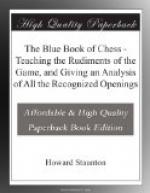{PGN 25}
[Event “?”] [Site “?”] [Date “????.??.??”] [Round “?”] [White “Anderssen”] [Black “Morphy”] [Result “1/2-1/2”] [ECO “C77”] [Annotator “The Blue Book of Chess, Game I., p. 98.”] [PlyCount “88”]
1. e4 e5 2. Nf3 Nc6 3. Bb5 a6 4. Ba4 Nf6 5. d3 Bc5 6. c3 b5 7. Bc2 d5 8. exd5 Nxd5 9. h3 O-O 10. O-O h6 11. d4 exd4 12. cxd4 Bb6 13. Nc3 Ndb4 14. Bb1 Be6 15. a3 Nd5 16. Ne2 Nf6 17. Be3 Re8 18. Ng3 Bc4 19. Nf5 Bxf1 20. Qxf1 Ne7 21. N3h4 Nxf5 22. Nxf5 Qd7 23. Bxh6 gxh6 24. Qc1 Bxd4 25. Qxh6 Re1+ 26. Kh2 Ne4 27. Bxe4 Rxe4 28. Qg5+ Kf8 29. Qh6+ Ke8 30. Nxd4 Qd6+ 31. Qxd6 cxd6 32. Rd1 Kf8 33. Rd2 Rae8 34. g4 R8e5 35. f3 Re1 36. h4 Rd5 37. Kg3 a5 38. h5 Kg8 39. Kf2 Re8 40. Kg3 Kh7 41. Kf4 Re7 42. Kg3 f6 43. Kf4 Re8 44. Kg3 Re7 1/2-1/2
{PGN 26}
[Event “?”] [Site “?”] [Date “????.??.??”] [Round “?”] [White “Lasker, E.”] [Black “Steinitz, Wm.”] [Result “1-0”] [ECO “C62”] [Annotator “The Blue Book of Chess, Game II., p. 99.”] [PlyCount “91”]
1. e4 e5 2. Nf3 Nc6 3. Bb5 d6 4. d4 Bd7 5. Nc3 Nge7 6. Be3 {White in this instance had probably made up his mind to adopt the plan frequently employed by Gunsberg in the Giuoco Piano, namely, playing Qd2 and O-O-O rapidly. —Gunsberg.} Ng6 {Black’s difficulty is how to dispose of the Kt. Now g6 in this instance, although perhaps preferable, is not a good place either, subject as it must be to an early attack from the h pawn—Hoffer.} 7. Qd2 Be7 8. O-O-O a6 9. Be2 exd4 10. Nxd4 Nxd4 11. Qxd4 {If Bxd4, Nf4; and the Kt. cannot be captured on account of Bg5 winning the Queen.—Leeds Mercury.} Bf6 12. Qd2 Bc6 {There seems little use in this move. Either he can O-O now; if not, then it is proof positive that his defence is bad.—Gunsberg.} 13. Nd5 O-O 14. g4 {This premature advance is admirably taken advantage of by Steinitz. —Leeds Mercury.} Re8 {Although this looks like a defensive move, to make room for the Kt., it is a subtle design which was entirely overlooked by Lasker. —Hoffer.} 15. g5 $2 Bxd5 16. Qxd5 {But here is a great mistake, which ought to lose the game. exd5 would have averted the loss of a Pawn, but at the expense of position and attack; he was outplayed by Steinitz up to this point.} Re5 $1 17. Qd2 Bxg5 18. f4 Rxe4 19. fxg5 Qe7 20. Rdf1 {From this move to the end Lasker exhibits most marvellous power of resource. With Rdf1 he commenced one of the most ingenious attacks.} Rxe3 21. Bc4 Nh8 22. h4 c6 23. g6 $1 {One of the moves which will make this game memorable. The object is, if hxg6 to open up the Rook’s file by h5. Allowance must of course be made for the fact that, being two Pawns behind, White has nothing to lose and everything to gain by desperate tactics.—Gunsberg.} d5 24. gxh7+ Kxh7 25. Bd3+ Kg8 26. h5 Re8 27. h6 g6 28. h7+ Kg7 29. Kb1 Qe5 30. a3 {Exhibiting consummate coolness in a ‘do or die’ predicament.—Pollock.} c5 31. Qf2 c4 $1 32. Qh4 f6 33. Bf5 $1 {Bf5 is evidence with what perfect lucidity Lasker




